 |
| Category: Air support |

|
This page is a
sub-category index |
|
|
|
| Fixed
wing page 1 |
Fixed
wing page 2 |
Helicopters Page
1 |
- Fairey Firefly
- Fairey IIID
- Fairey Gannet
- De Havilland Sea Venom
- De Havilland Vampire
- Douglas Dakota long nose
- Sea Otter
See these planes on Naval
Air 1
|
- GAF Jindivik
- Grumman Tracker
- Macchi MB 326
- Hawker Siddeley HS.748
- McDonnell Douglas Skyhawk
- Sea Fury
-
See these planes on Naval
Air 2
|
|
| 1914.The
Australian Naval and Military Expeditionary Force took two aircraft
with them to support their operations in New Guinea. |
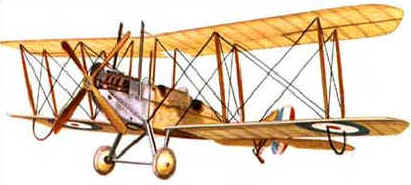
|
The
two aircraft, a Maurice Farman Floatplane and a BE2a
(BE2c shown left)
were taken from the
Central Flying School in Point Cook.
The German forces in New Guinea were
quickly overrun and the two aircraft remained in their crates until
returned to Australia.
|
The
Royal Australian Navy first became involved in naval aviation during
World War 1 when aircraft were operated from the gun turret launching
platforms of RAN cruisers operating with the Royal Navy.
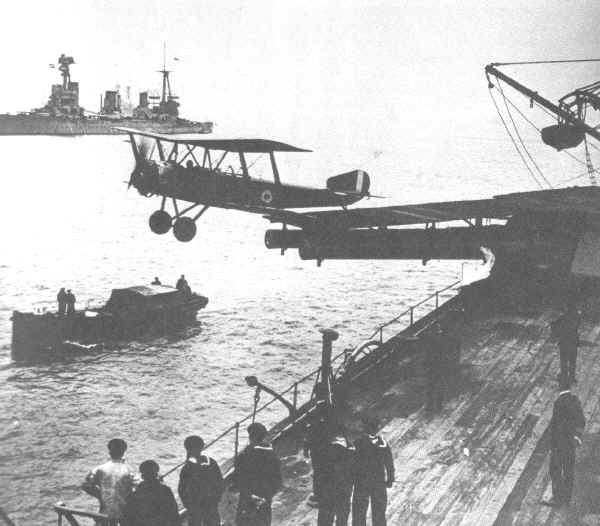 |
| A
plane leaving the turret platform of HMAS AUSTRALIA, 1918 |
 |
After
the war, a purpose built seaplane carrier, HMAS ALBATROSS, was
commissioned in 1929.
However, operating expenses were high and in 1933
the ship was placed in reserve - finally being sold to the Royal Navy
1938.
|
| During World War 2, RAN cruisers
carried aircraft flown and maintained by RAAF personnel with the RAN
providing the observers.
The Seagull during
WW2, flying over "mother", HMAS HOBART>>
|
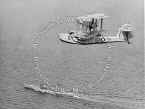
|
When the British Pacific Fleet came to
Australia in the latter part of the war, about 24 RAAF pilots
volunteered to transfer to the Royal Australian Navy Volunteer Reserve
(RANVR) and these men subsequently served aboard RN aircraft carriers
and at RN Air Stations established in Australia.
| After
the war, the Australian Government recognised the importance
of sea-borne air power and in 1947 authorised the formation of
the RAN Fleet Air Arm.
The FAA came into being with
the commissioning in 1948 of the Air
Station HMAS ALBATROSS (at Nowra),
805 Squadron (Sea Furies) and 816 Squadron (Fireflies).
|
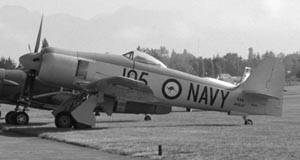 |
The following year the Light Fleet
Carrier, HMAS SYDNEY,
was commissioned. Two further Squadrons, 808 and 817 were commissioned
in 1950. In 1951, SYDNEY, with the Sydney Air Group embarked, sailed
north to take part in the Korean War.
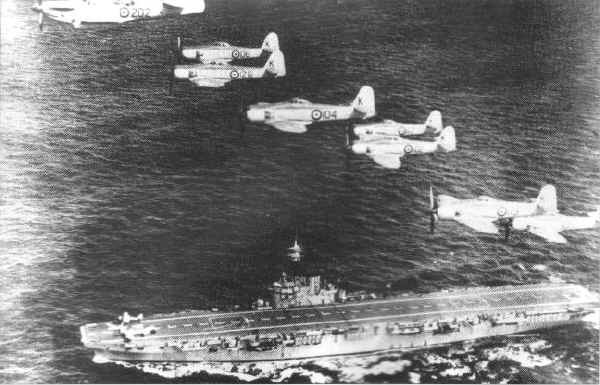
HMAS Sydney ends
her Tour of Duty in Korea with her planes flying ceremonial escort
It was the intention of the
Australian Government to equip the RAN with two aircraft carriers but
technical advances meant that the second carrier, HMAS MELBOURNE,
would require fitting with an angled deck and a steam catapult to
accommodate the new generation of aircraft. 

Whilst MELBOURNE was
undergoing modernisation, the Royal Navy loaned to Australia the
aircraft carrier VENGEANCE. HMAS MELBOURNE commissioned in 1956 and at
the same time the RAN acquired Sea Venom all weather fighters and
Gannet anti- submarine aircraft.
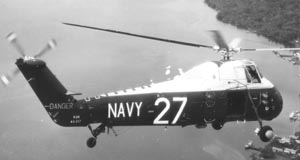 |
The
RAN introduced helicopters into operational service early in
the development of this technology - firstly Bristol Sycamores
and then the anti-submarine Westland Wessex.
As SYDNEY could not operate
Sea Venoms and Gannets the ship changed to a training role and
later became a troop carrier taking men and material to the
war in Vietnam. 
|
|
"The Vung
Tau Ferry"
HMAS Sydney .
May 1965 -11th March 1972
The troop transport HMAS
Sydney was the first RAN ship to have operational service in
Vietnam. She completed 22 voyages in 7 years.
Sydney was a former air craft
carrier that had served in the Korean War.
She was converted to a troop
carrier and ran an almost ferry like service between Australia
and Vung Tau for the 7 years of her commitment to the Viet Nam
conflict.
|
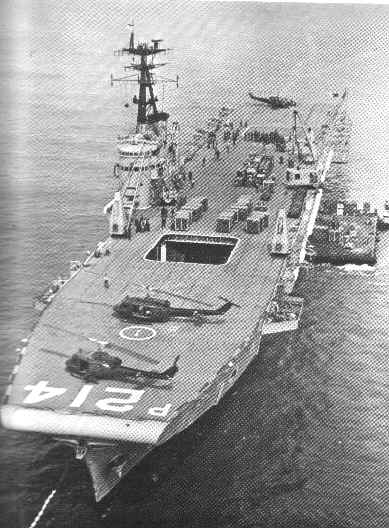 |
- HMAS SYDNEY paid off in 1975 after a
very distinguished commission.
The Fleet Air Arm was heavily involved in the Vietnam War with aircrew
and maintenance personnel from 723 Squadron serving in-country with 9
Squadron RAAF and the United States Army's 135th Assault Helicopter
Company. During the fifties and sixties, MELBOURNE and her squadrons
took part in operations in the Far East Strategic Reserve. In 1967 the
MELBOURNE took delivery of a new generation of aircraft, the Douglas
Skyhawk (A4G) and the Grumman Tracker (S2E). In the early seventies
the Westland Sea King helicopter was introduced as the Wessex
replacement.
|
The paying-off of MELBOURNE
in 1983 marked the closing of the RAN fixed-wing aircraft
carrier era.
However, the Fleet Air Arm
continues its role in providing sea-borne air power and the
focus today is on the embarked helicopters.  |
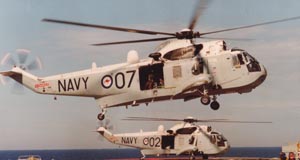 |
The Sea Kings, Squirrels and the
Seahawks helicopters continue to provide the Royal Australian Navy
with a significant capability afloat. The Kaman Seasprite (SH2-G) is
the most recent acquisition of rotary wing aircraft for RAN
|
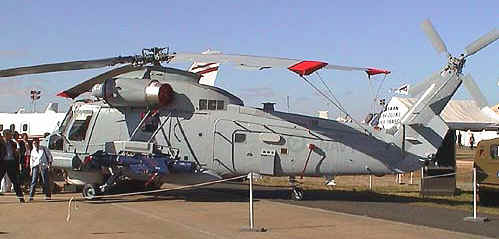
|
| The RAN's first Kaman SH-2G
Seasprite N29-161656 at Avalon, Vic., 12 Feb. 2001. (Courtesy
Andrew Skorzetz - Andrew's Australian Aviation Photos |
The RAN Fleet Air Arm has seen
active service in Korea, the Malaya Emergency, Indonesian
Confrontation, Vietnam, the Gulf War, East Timor and more recently,
the War Against Terrorism.
Over the years since 1948, the
RAN Fleet Air Arm has operated 22 different types of aircraft - a real
challenge to the aircrew and the maintenance personnel.
The RAN Fleet Air Arm has forged a proud tradition over
the years. A tradition of professional service and outstanding
achievements. The Fleet Air Arm men and women of today carry on these
high standards of dedicated service.
Admiral Sir Victor Smith, regarded as the "Father" of the
RAN Fleet Air Arm, in the nineteen fifties adopted the
motto-:"Second to None" for the FAA. This motto is as true
today as it was in Sir Victor's day. 
Partly from
http://www.faaaa.asn.au/history.html
|
|
THE RAN FLEET AIR
ARM
The decision to build an
airfield on the land now occupied by the home of the Fleet Air Arm, HMAS
ALBATROSS, was taken soon after the declaration of WWII in 1939. In
1944, the British Admiralty directed certain Naval forces to the South
West Pacific area, and this of course necessitated the provision of
shore base establishments for the Royal Navy and its Fleet Air Arm in
Australia.
On 3 July 1947, the Commonwealth Defence Council approved the formation
of a Fleet Air Arm which would be controlled and operated by the Royal
Australian Navy. The initial planning provided for the purchase of two
aircraft carriers, necessary aircraft and the establishment of shore
facilities. The carriers were later named HMA Ships SYDNEY and MELBOURNE
and the shore facilities were established at Nowra, NSW.
HMAS Albatross was commissioned on 31 August 1948 and the 20 Carrier Air
Group,comprising Sea Fury and Firefly aircraft, were transported from
England to Australia onboard the carrier HMAS SYDNEY. These aircraft,
operated by 805 and 816 Squadrons, disembarked to Nowra in May 1949. In
November 1950, they were joined by the 21st Carrier Air Group of 808 and
817 Squadrons also flying Sea Furies and Fireflies. 
The Fleet Air Arm has been expanding ever since. As more capable
aircraft have been acquired, so ground support facilities have had to be
built to service the more sophisticated equipment. In April 1955, Sea
Venoms and Gannets arrived and as a consequence radar workshops and
additional test facilities were required.
In 1965, it was decided to buy American aircraft to replace the ageing
British Gannets and Sea Venoms. MacDonnell Douglas A4G Skyhawks and
Grumman S2E Trackers were obtained to operate from the carrier and Fleet
Flagship HMAS MELBOURNE. The Fleet Air Arm has in service the SeaHawk
helicopter which restored to the RAN many of the capabilities lost when
the Tracker Squadrons disbanded in 1983, and is currently negotiating
the purchase of 11 Kaman SH.2G(A) Super Seasprite helicopters to enhance
the war fighting capability of the new ANZAC class frigates.
The Fleet Air Arm of today comprises not only operational squadrons but
also a vast support network dedicated to maintaining those aircraft and
improving the skills of the individuals who maintain and operate them.
Departments such as the Aircraft Maintenance and Flight Training Unit (AMAFTU)
are responsible for the trial, installation and development of
modifications to aircraft, as well as the development of procedural
guidelines for the operation of aircraft from various classes of ship.
The Air Warfare Systems Centre (AWSC) offers full mission training on
Sea King and SeaHawk simulators. The Centre is also responsible for the
development and maintenance of complex SeaHawk computer software.
The history of the Fleet Air Arm has not been lost either - the RAN
Historic Flight was formed in 1985 with the aim of restoring to flying
condition as many ex - Navy aircraft types as possible. It is a separate
activity to that of the Naval Aviation Museum. Established in 1974, the
Naval Aviation Museum aims to preserve the heritage of Australian Naval
Aviation and the Fleet Air Arm. It also endeavours to present the deeds
and sacrifices of those naval air personnel who have served their
country both in war and peace. 
http://www.navy.gov.au
|
|